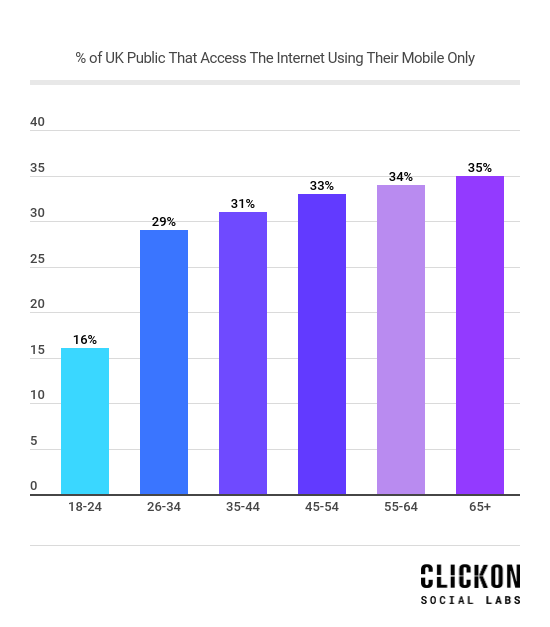Are We Living In A Mobile Only World?
If brands hope to hold their consumer's attention, focus should move away from optimising content for desktop and instead, focus more on mobile.
- Content distribution is a vital part of the production process. Now that mobile is omnipresent, marketers need to focus more on optimising their content for mobile phones.
- The CLICKON Social Labs poll illustrates the distribution across age, of people that access the Internet using their mobile phones only.
- 16% of 18-24 year-olds said they are mobile only, but this figure doubles at 35-44 year-olds and continues to increases with age.
CLICKON Social Labs noticed some new trends in marketing, that mean content is being increasingly optimised for mobile phone use. In a poll of 5,467 participants, each age group was asked who accesses the Internet by using their mobile phones only.
Mobile, as we know it today, has been present for approximately the last 20 years. However, in that time, it has stormed the marketing world and the worlds of consumers. Meaning, that if brands do not harness this opportunity, they will lose out on achieving maximum potential reach.
Back in the day, the first record of mobile phones were not really mobile phones. They were effectively a two-way radio, which allowed people, for example in emergency services, to communicate.
From 1908 when a US Patent in Kentucky was given one of the first wireless telephones, to 2019 being the year that 5G phones launch, mobile’s progress is unparalleled. Although the advertising industry thought of mobile as a top priority, now it should be mobile is the only priority.
 What may appear surprising, is that the older, not younger, generations are more mobile only. In a time where a current trend is centred on trying to engage Gen Z, of which some fall into the 18-24 bracket, it is apparent that efforts should primarily be focused on engaging the older generations through mobile.
What may appear surprising, is that the older, not younger, generations are more mobile only. In a time where a current trend is centred on trying to engage Gen Z, of which some fall into the 18-24 bracket, it is apparent that efforts should primarily be focused on engaging the older generations through mobile.
There are more than double 55-64 year-olds than 18-24, who access the internet through mobile only. There are a number of reasons that this could be down to:
-
The younger generations are at University, and will need access to a laptop for work.
-
The younger generation will be in entry level jobs where they are sat at a desk, using a computer quite frequently.
-
The older generation may be in early retirement and have no need to access desktops.
-
If the older generation is at a high level in their career, the mundane jobs they may have had to do previously could be done by other team members, and so they would mainly attend meetings and do work that does not involve being sat at a computer.
Regardless of the age group, a key element of mobile to consider, is their aim to deliver key messages in short times.
In addition, the ability to pinch and zoom in on mobile provides audiences with the ability to look closer and really examine content that is advertised to them, meaning, the work of marketers is held under even further scrutiny. Therefore, in order to keep in line with the new ways content is viewed, advertising needs to be held to a higher standard.
The fact that each of these age groups even consider mobile only, provides clear evidence that mobile has become omnipresent in people's lives. Marketers are able to target audiences directly, as most users will always be within arm’s reach of their mobile phones, whether they are commuting, at work, or at home - they have access to their mobiles even when other media is not available. This concept is of utmost importance for marketers as it means that audiences can always be reached, and always be interrupted.
By 2019, mobile will be responsible for “72% of US Digital Ad Spend”, with the average person's use increasing by 11 minutes per day, each year. So if brands want to stay in the eye of the consumer, they should not be thinking of mobile first, but mobile only.
